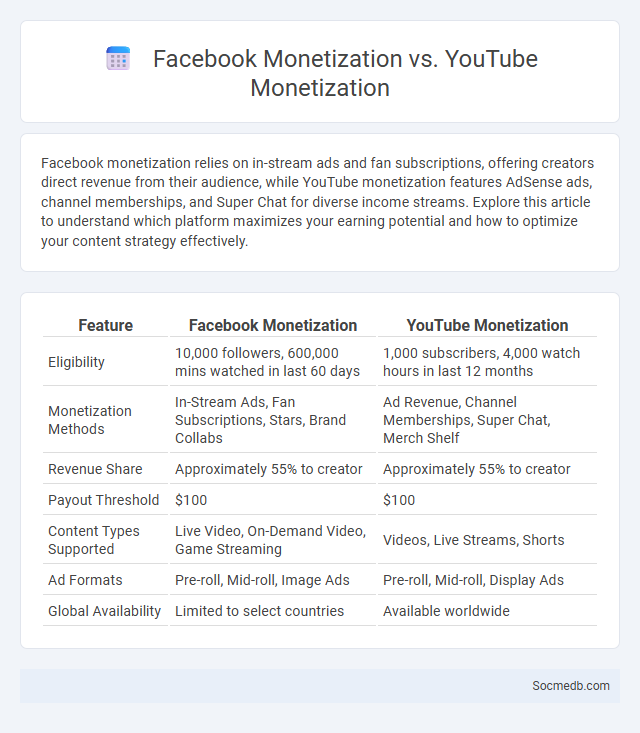
Photo illustration: Facebook Monetization vs YouTube Monetization
Facebook monetization relies on in-stream ads and fan subscriptions, offering creators direct revenue from their audience, while YouTube monetization features AdSense ads, channel memberships, and Super Chat for diverse income streams. Explore this article to understand which platform maximizes your earning potential and how to optimize your content strategy effectively.
Table of Comparison
| Feature | Facebook Monetization | YouTube Monetization |
|---|---|---|
| Eligibility | 10,000 followers, 600,000 mins watched in last 60 days | 1,000 subscribers, 4,000 watch hours in last 12 months |
| Monetization Methods | In-Stream Ads, Fan Subscriptions, Stars, Brand Collabs | Ad Revenue, Channel Memberships, Super Chat, Merch Shelf |
| Revenue Share | Approximately 55% to creator | Approximately 55% to creator |
| Payout Threshold | $100 | $100 |
| Content Types Supported | Live Video, On-Demand Video, Game Streaming | Videos, Live Streams, Shorts |
| Ad Formats | Pre-roll, Mid-roll, Image Ads | Pre-roll, Mid-roll, Display Ads |
| Global Availability | Limited to select countries | Available worldwide |
Introduction to Online Monetization Platforms
Online monetization platforms transform social media engagement into revenue by enabling content creators to earn through ads, sponsorships, and fan support. Platforms like YouTube, Instagram, and TikTok offer built-in tools such as affiliate marketing, paid subscriptions, and tipping features to maximize earning potential. Understanding algorithms and audience analytics is essential for optimizing content reach and driving sustainable income streams.
Overview of Facebook Monetization
Facebook monetization enables content creators and businesses to generate revenue through various features, including in-stream ads, fan subscriptions, and branded content partnerships. The platform's monetization tools leverage user engagement data and targeted advertising to maximize income potential. Facebook also offers analytics and audience insights to optimize content strategies for higher profitability.
Overview of YouTube Monetization
YouTube monetization enables content creators to earn revenue through ads, channel memberships, Super Chat, and YouTube Premium revenue. To qualify, your channel must have at least 1,000 subscribers and 4,000 watch hours in the past 12 months, meeting YouTube's Partner Program policies. Optimizing video content with relevant keywords and viewer engagement boosts your monetization potential and overall channel growth.
Key Differences: Facebook vs YouTube Monetization
Facebook monetization primarily depends on in-stream ads, fan subscriptions, and brand collaborations, with eligibility requiring a minimum of 10,000 followers and 600,000 total minutes viewed in the last 60 days. YouTube monetization centers around the YouTube Partner Program, requiring 1,000 subscribers and 4,000 watch hours over the past 12 months to enable ad revenue sharing, channel memberships, and Super Chats. While Facebook emphasizes community engagement and direct fan support, YouTube provides broader revenue streams through video ads and a more established content creator ecosystem.
Eligibility Requirements Comparison
Social media platforms have varied eligibility requirements based on age, location, and content guidelines, impacting your ability to create and maintain accounts. For example, Facebook and Instagram require users to be at least 13 years old, while TikTok enforces a minimum age of 16 in some regions to comply with local privacy laws. Understanding these differences ensures you meet each platform's criteria and avoid account suspension or removal.
Revenue Streams on Facebook vs YouTube
Facebook generates significant revenue through targeted advertising and in-app purchases, leveraging its vast user data for precise audience segmentation. YouTube's primary income source is ad revenue from video ads, supplemented by YouTube Premium subscriptions and channel memberships that offer creators monetization opportunities. Understanding these distinct revenue streams helps you choose the best platform for maximizing your content's profitability.
Audience Engagement and Algorithm Impacts
Social media platforms prioritize audience engagement metrics such as likes, comments, and shares, which directly influence the visibility of your content through complex algorithms. Algorithms analyze user behavior and preferences to tailor content feeds, making it essential to create interactive and relevant posts that resonate with your target audience. Maximizing engagement increases your reach and strengthens connections, ultimately driving growth and brand loyalty across social networks.
Payout Structures and Payment Thresholds
Social media platforms typically implement payout structures based on user engagement metrics such as views, clicks, or content interactions, with creators earning a percentage of ad revenue or fixed payments per activity. Payment thresholds vary widely, often requiring users to accumulate a minimum amount, commonly ranging from $10 to $100, before funds can be withdrawn. These thresholds help platforms manage transaction fees and verify account legitimacy while ensuring creators consistently produce content to reach payout eligibility.
Challenges and Limitations of Each Platform
Social media platforms face distinct challenges and limitations that impact user experience and content dissemination; for instance, Facebook struggles with privacy concerns and misinformation spread, while Instagram grapples with algorithmic bias and mental health effects on younger users. Twitter's character limit restricts nuanced communication, leading to misinterpretations and rapid misinformation circulation, whereas TikTok's short-form video format can limit depth and promote addictive usage patterns. LinkedIn faces issues with spam and professional credibility, and YouTube contends with content moderation challenges and monetization inconsistencies affecting creators.
Choosing the Best Monetization Platform for Your Content
Selecting the best monetization platform for your content involves evaluating factors such as audience demographics, engagement rates, and revenue models. Platforms like YouTube, Instagram, TikTok, and Patreon offer diverse monetization options including ad revenue, sponsored posts, affiliate marketing, and direct fan support. Understanding your content niche and aligning it with a platform's strengths ensures you maximize your earning potential and grow your brand effectively.
 socmedb.com
socmedb.com